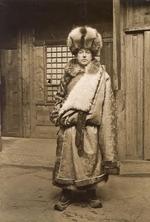The Rock collection consists of correspondence, photographs, diaries and unpublished manuscripts.
The Joseph Rock Collection
This material is held atRoyal Botanic Garden Edinburgh Archives
- Reference
- GB 235 JFR
- Dates of Creation
- 1884 - 1962
- Name of Creator
- Language of Material
- English Chinese Tibetan
- Physical Description
- extensive collection comprising 2 bays - between 5 and 6 metres
- Digital Content
Scope and Content
Administrative / Biographical History
Born Vienna, Austria 1884; died Hawaii 1962
Relatively uneducated, penniless and often in poor health Joseph Rock left Vienna as a young man in 1902, travelling through Europe and on to the United States. Moving to Hawaii where he was appointed by the Division of Forestry as its first botanical collector, he became a naturalised American in 1913. Although self taught as a botanist, Rock was appointed lecturer at the College in Hawaii, established its first herbarium, and served as its first curator from 1911 until 1920. In 1920 he was appointed by the US Department of Agriculture to find a tree in south east Asia the oil from which was supposed to be useful in treating leprosy. This was the start of his new life as an explorer and in 1922 he arrived in Lijiang, Yunnan which was to become his ‘home’ province though he also travelled widely in Szechuan, Gansu and also Tibet. He was to spend the next 27 years living among the people of the Western Provinces of China collecting plants for western museums and exploring and mapping mountains on the Tibetan border. Working for organisations such as Harvard University’s Arnold Arboretum, the United States Department of Agriculture, the United States Natural History Museum and the National Geographic Society, he photographed and wrote about the indigenous plants, people and geography of the remote region. He entered the lamaseries of Tibet and became deeply involved in the social and political conditions that affected Western China, witnessing much brutality during various rebellions. He was forced to leave communist China in 1949, but continued travelling around the world, eventually returning to Hawaii where he died in 1962. Rock bequeathed his extensive photographic collection to the archives of the Royal Botanic Garden Edinburgh, alongside his diaries documenting his travels.
Source: ‘In China’s Border Provinces; The Turbulent Career of Joseph Rock’ S.B. Sutton. ‘Joseph Rock and His Shangri-La’ Jim Goodman. Archives
D.W.
Arrangement
The Rock collection has been arranged by Unpublished Manuscripts (JFR/1) which include Rock's diaries and their associated transcripts that were compiled by Rock (JFR/1/1); Expedition Records and Fieldnotes (JFR/2); Correspondence (JFR/3); Publications (JFR/4) and an extensive collection of photographs (JFR/5).
Access Information
Collection is open to researchers by appointment, see (right click, open link in new tab:) https://www.rbge.org.uk/science-and-conservation/library-and-archives/visiting-the-library/
Acquisition Information
Rock's diaries, photographs and manuscripts were bequeathed to RBGE, but the collection also includes documents that were generated by RBGE.
Note
Born Vienna, Austria 1884; died Hawaii 1962
Relatively uneducated, penniless and often in poor health Joseph Rock left Vienna as a young man in 1902, travelling through Europe and on to the United States. Moving to Hawaii where he was appointed by the Division of Forestry as its first botanical collector, he became a naturalised American in 1913. Although self taught as a botanist, Rock was appointed lecturer at the College in Hawaii, established its first herbarium, and served as its first curator from 1911 until 1920. In 1920 he was appointed by the US Department of Agriculture to find a tree in south east Asia the oil from which was supposed to be useful in treating leprosy. This was the start of his new life as an explorer and in 1922 he arrived in Lijiang, Yunnan which was to become his ‘home’ province though he also travelled widely in Szechuan, Gansu and also Tibet. He was to spend the next 27 years living among the people of the Western Provinces of China collecting plants for western museums and exploring and mapping mountains on the Tibetan border. Working for organisations such as Harvard University’s Arnold Arboretum, the United States Department of Agriculture, the United States Natural History Museum and the National Geographic Society, he photographed and wrote about the indigenous plants, people and geography of the remote region. He entered the lamaseries of Tibet and became deeply involved in the social and political conditions that affected Western China, witnessing much brutality during various rebellions. He was forced to leave communist China in 1949, but continued travelling around the world, eventually returning to Hawaii where he died in 1962. Rock bequeathed his extensive photographic collection to the archives of the Royal Botanic Garden Edinburgh, alongside his diaries documenting his travels.
Source: ‘In China’s Border Provinces; The Turbulent Career of Joseph Rock’ S.B. Sutton. ‘Joseph Rock and His Shangri-La’ Jim Goodman. Archives
D.W.
Other Finding Aids
(right click, open link in new tab) https://www.rbge.org.uk/media/6360/GB235jfr_josephfrock.pdf
Archivist's Note
Collection originally catalogued by L. Paterson 2015.
Description revised and renumbered by L. Paterson in June-July 2024.
This collection may contain, either in its content or catalogue descriptions, terminology, language and attitudes which are today considered inappropriate, outdated, offensive or distressing.
Conditions Governing Use
Permission is required from RBGE but many of the photographs may have reproduction restrictions as copyright may belong to external organisations.
Additional Information
published

